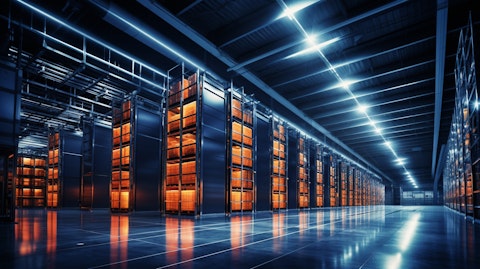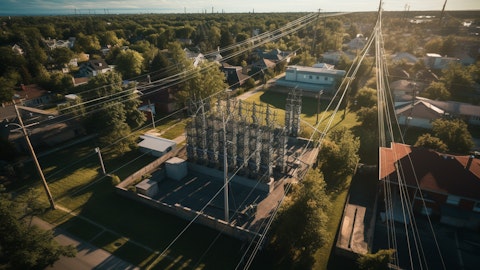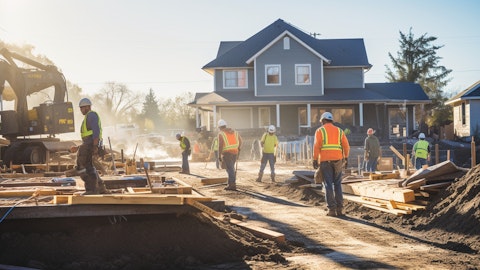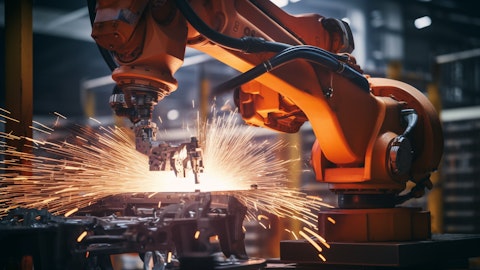Olympic Steel, Inc. (NASDAQ:ZEUS) Q2 2025 Earnings Call Transcript August 1, 2025
Operator: Good morning, and welcome to the Olympic Steel 2025 Second Quarter Financial Results Conference Call. [Operator Instructions] As a reminder, this conference is being recorded. At this time, I’d like to hand the conference over to Rich Manson, Chief Financial Officer at Olympic Steel. Please go ahead, sir.
Richard A. Manson: Thank you, operator. Welcome to Olympic Steel’s earnings call for the second quarter of 2025. Our call this morning will be hosted by our Chief Executive Officer, Rick Marabito; and we will also be joined by our President and Chief Operating Officer, Andrew Greiff. Before we begin, I have a few reminders. Some statements made on today’s call will be predictive and are intended to be made as forward-looking within the safe harbor provisions of the Private Securities Litigation Reform Act of 1995 and may not reflect actual results. The company does not undertake to update such statements, changes in assumptions or changes in other factors affecting such forward-looking statements. Important assumptions, risks, uncertainties and other factors that could cause actual results to differ materially are set forth in the company’s reports on Form 10-K and 10-Q and the press releases filed with the Securities and Exchange Commission.
During today’s discussion, we may refer to adjusted net income per diluted share, EBITDA and adjusted EBITDA, which are all non- GAAP financial measures. A reconciliation of these non-GAAP measures to the most directly comparable GAAP financial measures is provided in the press release that was issued last night and can be found on our website. Today’s live broadcast will be archived and available for replay on Olympic Steel’s website. Now I’ll turn the call over to Rick.
Richard T. Marabito: Thank you, Rich, and good morning, everyone. Thank you for joining us today to discuss Olympic Steel’s 2025 second quarter results. I’ll begin by providing some perspective on our performance in the second quarter and how we’re navigating the current environment. Andrew will then review our segment performance. And following that, Rich will discuss our financial results in more detail. And then as always, we’ll open the call up for your questions. As we all know, news around tariffs has been dominating the headlines and creating uncertainty throughout the manufacturing industry, the metal supply chain and with our customers. Despite that uncertainty, our strategies and disciplined approach, combined with the strong foundation we have built for a more resilient Olympic Steel resulted in solid performance in a challenging environment.
In the second quarter, we reported sales of $496 million and net income of $5.2 million. As we mentioned on our last call, we saw significant buy-ahead activity by our customers late in the first quarter as they reacted to the initial steel and aluminum tariffs and the potential for reciprocal tariffs. As a result, there was some sequential volume pullback in the second quarter, yet our flat-rolled shipping volumes for the first half of 2025 remained slightly ahead of volume for the first half of 2024, while the industry actually experienced contraction for that period. While second quarter volumes were down sequentially, margins from our flat-rolled business improved, and we delivered adjusted EBITDA of $20.3 million. That’s a 26% increase compared with the first quarter.
And importantly, all 3 of our business segments continued to deliver positive EBITDA. This performance is the result of our strategy to build a stronger, more resilient Olympic Steel. Our efforts to diversify into higher-value metal-intensive products, expand our fabricating capabilities and lean into our operational disciplines have put us in a position to deliver profitable results even when industry shipping volumes and pricing are falling. With a strong balance sheet and more than $300 million of borrowing availability, we are in an excellent financial position to make additional accretive acquisitions as well as fund our organic investments to drive profitable growth, further efficiencies and enhance safety in our operations. As we previously announced, our robust 2025 CapEx plan, which includes new processing and automation equipment continues to proceed as scheduled.
Andrew will share more specifics in a few moments. Our track record on the M&A front has been highly successful, completing 8 acquisitions in the last 7 years. The integration of our most recent acquisition, MetalWorks, has gone seamlessly and their results have been accretive to earnings. As we look ahead to the second half of the year, we expect the environment will remain challenging. We do, however, see a few positive emerging trends like resolution of reciprocal tariffs and the new tax legislation that reinforce our optimism for the longer-term outlook for the steel industry and especially for Olympic Steel. Andrew will have more to share on that in his comments. As always, I’m proud of our team for their hard work and dedication to Olympic Steel.
I’m confident that together, we continue to build on our strengths and ensure Olympic Steel continues to deliver profitable results no matter the market environment. I’ll now turn the call over to Andrew.
Andrew S. Greiff: Thank you, Rick, and good morning, everyone. We continue to navigate an unprecedented environment for the metals industry. As previously noted, the 25% sequential increase in first quarter 2025 volume was generated by purchasing ahead of anticipated price increases. Shipping data from our trade association indicates that the most products, service center shipping rates in 2025 are below 2024. Despite this negative trend, our first half 2025 flat-rolled shipments remain above our first half 2024 shipping levels. As Rick discussed, our team has done an excellent job positioning Olympic Steel for success in even the toughest markets. During the second quarter, we improved margins for our flat-rolled products. This improvement, combined with the steadiness of our end products businesses helped to drive a 26% sequential increase in adjusted EBITDA, showing once again our ability to be profitable in the face of challenging conditions.

This was an outstanding effort by our team to stay focused on controlling what we can control. Second quarter activity in our Carbon segment reflected the overall metals industry sentiment. Profitability remained solid with second quarter EBITDA of $12.5 million with strength from our manufactured product companies. The pipe and tube segment recorded adjusted EBITDA of $6.7 million. The Pipe and Tube team continues to focus on fabrication with the goal to grow this business and drive margin improvement. We expect improved second half 2025 demand for data center work related to Pipe and Tube. Business conditions for both stainless and aluminum products began to improve during the second quarter, resulting in sequential improvements in both volume and profitability for the Specialty Metals Group.
EBITDA was $5.9 million, and more than 60% improvement from the first quarter. We also gained market share across our stainless and aluminum product lines. We are seeing momentum in the market for the second half of 2025 following the doubling of Section 232 tariffs on steel and aluminum to 50% and subsequent domestic mill price increases. Our robust CapEx plan for 2025 includes $35 million of spending, primarily on organic growth opportunities, which include a new cut-to-length line in Minneapolis, Minnesota, a new white metals cut-to-length line in Schaumburg, Illinois, the automation of our warehouse in Chambersburg, PA, and the expansion of Action Stainless’s presence in Houston, Texas, along with a new high-speed stainless slitter at our Berlin Metals operation outside of Gary, Indiana.
With the exception of the slitter, the other projects are expected to be operational by the end of 2025 and will help fuel our growth in 2026 and beyond. The Berlin slitter is expected to be operational by the end of the first quarter of 2026. While we expect market uncertainty to remain in the near term, we are encouraged by the emerging trends and opportunities for the steel industry. For example, we are seeing increased inquiries for fabrication services, especially amongst OEMs looking to onshore, outsource or expand their first stages of manufacturing in the U.S. Olympic Steel is well positioned to capitalize on the trend to increase U.S. manufacturing in the months and years to come. We are a resilient organization with the right strategy to lead us into the future, drive our growth and help us deliver profitable results under all market conditions.
With that, I’ll turn the call over to Rich.
Richard A. Manson: Thank you, Andrew. As you’ve heard from both Rick and Andrew, our team did an excellent job delivering solid results during the second quarter despite significant macroeconomic challenges and uncertainty. The benefits of our focus on controlling what we can control is apparent in our results. Before I discuss the results in more detail, I want to remind everyone that comparisons are impacted by the November 2024 acquisition of MetalWorks, whose results are included in the Carbon segment. Second quarter net income totaled $5.2 million compared with $7.7 million in the second quarter of 2024. Adjusted EBITDA in the quarter was $20.3 million compared with $21.3 million in the prior year period. These results include $750,000 of LIFO expense in the second quarter of 2025 compared with $1 million of LIFO pre-tax income in the second quarter of 2024.
Adjusted EBITDA for the second quarter of 2025 was 26% stronger than the adjusted EBITDA for the first quarter of 2025. Consolidated operating expenses for the second quarter totaled $110.4 million compared with $104.6 million in the second quarter of 2024. Our second quarter 2025 operating expenses reflect the addition of MetalWorks, which does not report tons sold. Therefore, operating expenses per ton at the consolidated level and for the Carbon segment will appear higher year-over-year. As a reminder, we do not report tons sold for McCullough Industries, EZ-Dumper, Metal-Fab, Shaw Stainless or the entire Pipe and Tube segment. Second quarter consolidated operating expenses included $2.5 million of MetalWorks operating and acquisition-related expenses and $200,000 of lower incentive expenses when compared to the second quarter of 2024.
We reduced debt during the second quarter, bringing our total debt to $233 million, which is $39 million lower than year-end levels. We have approximately $305 million of availability under our asset-based revolving credit facility, providing us with an excellent source of flexible, low-cost capital to fund our strategic growth initiatives. Total capital expenditures totaled $17.5 million in the first half of 2025 compared with depreciation of $13 million. We estimate that 2025 capital expenditures will be approximately $35 million. The investment is higher than historical levels as we focus on supporting our automation and additional organic growth initiatives, as Andrew noted. Our second quarter 2025 effective tax rate was 29.1% compared with 28.4% in the same period last year.
We expect our 2025 tax rate to approximate 28% to 29%. In addition, we paid a quarterly dividend of $0.16 per share in the second quarter. Our Board of Directors approved our next regular quarterly cash dividend of $0.16 per share, which is payable on September 15, 2025, to shareholders of record on September 2, 2025. The company has now paid regular quarterly dividends dating back to 2006. Before we open the call for your questions, I would like to thank the entire Olympic Steel team for all their efforts in the second quarter. We know there are challenges and uncertainty, but we also know our business, our markets and our customers very well. Our team is executing in a consistent and strategic manner that enables us to deliver these results and to continue to build shareholder value.
Operator, we are now ready for questions.
Q&A Session
Follow Olympic Steel Inc (NASDAQ:ZEUS)
Follow Olympic Steel Inc (NASDAQ:ZEUS)
Receive real-time insider trading and news alerts
Operator: [Operator Instructions] Our first question comes from Samuel McKinney with KeyBanc Capital Markets.
Samuel J. McKinney: Thanks for the color earlier, Andrew, on some of the new equipment that you’re getting in. I wanted to dive a little more into the new processing and automation equipment that’s beginning to arrive. Just maybe talk a little more about the benefits that you’ll see once those pieces start to contribute and if possible, quantify some of the benefits that you’ll glean from those.
Andrew S. Greiff: Yes. Great question. Thanks, Sam. So this has been a project that has been years in making. The equipment is a combination of things, including high-speed lasers in addition to a whole [indiscernible] system that allows us to move product throughout the building with very little touch from employees. So part of the automation will be, number one, to improve safety so that we’re touching the product less. And it will, at some point, reduce the number of employees that we have in that specific location as the automation gets going.
Richard T. Marabito: And then some of the other CapEx that Andrew talked about also really will enhance productivity. So maybe you could talk about some of the new cut-to-length lines and the slitter also. I think those are…
Andrew S. Greiff: Sure. So we have — as you know, we have 2 cut-to-length lines. One is going into our Minneapolis facility. The other is going into our Schaumburg facility. The Schaumburg facility cut-to-length line will be primarily for aluminum. It’s a very fast-growing product line for us, as you know, Sam. The Minneapolis line is going to be a light gauge line. So going to be focusing a lot on galvanized and other tandem products as well as the new slitter that’s going to be going into our Berlin operation. That won’t be operational until the beginning of next year. But that is a very light gauge. So somewhere in the, call it, in the 0-10 range is what that will end up doing for us.
Richard T. Marabito: Yes. Then, Sam, in terms of kind of quantification, obviously, as Andrew said, most of the equipment is just becoming operational, call it, in the fourth quarter with the exception of the Berlin slitter, as you mentioned. So really, the ramp-up in terms of seeing the results in — our results will be more towards next year. As you know, we do a pretty rigorous process in terms of justification on CapEx and acquisitions. So we’re pretty excited about the return profiles of all 5 of these big projects. But you’d start to see them phasing in early next year.
Samuel J. McKinney: That was very helpful. And then it was great to see Pipe and Tube gross margins stay safely above that 30% mark. I know a component of that segment’s profitability transformation over the last few years has been the OEM outsourcing fabrication work. Any more detail you can provide on the work you’re doing for those OEMs, the incremental increase in interest since the tariff announcements or if some of that increase has also been on the carbon side?
Andrew S. Greiff: Well, the — it has been a continuation of the customer kind of as on the flat-rolled side, Sam, where instead of supplying the tube, they’re now looking for something else to be done. We have 19 high-speed tube lasers that are very active and going into a variety of industries. So very strong in the industrial OEMs and where we’re really seeing an increase in that business has been in the data centers. We’ve seen significant growth on that side of it. And so whether it’s in the Carbon side or even in the Stainless side for the Pipe and Tube, the growth has been pretty extraordinary on the fabrication.
Samuel J. McKinney: Okay. And then last one for me. Obviously, first quarter demand with some pull forward. And then coming off the second quarter volume decline in Carbon Flat, how were trends in July? And how do you think things are shaping up for August?
Richard A. Manson: Sam, it’s Rich. And I think what we typically see is this is a typical seasonal year, right? And what we’ve seen historically, say, over the last 5 to 6 years is third quarter is typically down 5% to 6% sequentially from Q2, and that’s really all due kind of to the July holiday. The first 2 weeks of July typically are very slow and didn’t see anything different this year than we typically see in other years.
Operator: Our next question comes from Dave Storms with Stonegate Investment Group.
David Joseph Storms: I just wanted to start with some of the flat-rolled margin improvements that you mentioned. How should we be thinking about maybe the main drivers of this margin improvement?
Richard A. Manson: David, it’s Rich. And I think it was just really kind of a function of how the index pricing changed throughout the first half of the year. And so obviously, index pricing shot up after the announcements in February with the tariffs. We had secured some inventory at lower pricing. That allowed you to sell that at higher prices coming into the second quarter. That’s essentially the margin improvement that you see based on index pricing.
Richard T. Marabito: Yes. And then the other thing I’d add — this is Rick, Dave. The other thing I’d add is, obviously, we’ve talked a lot about it the last several years. Strategically, as we’ve also tried to enrich our mix. And when I say enrich our mix, it’s everything, including on the Carbon side, doing more coated product, a product that carries a slightly higher pricing point and better margins. It’s doing more fabricating and value-add work. And a big piece of it is our acquisition strategy where we’ve gained diversification by owning some companies that make some end products. So it’s all of that. And sometimes when the markets start to recede is the time you see the manifestation of that. And so I think that’s part of what you’re seeing aside from the basics in the service center pricing market and where the cost of the metal is.
David Joseph Storms: That’s very helpful. I know you also mentioned in your prepared remarks, you’re seeing some inbound inquiries jumping up, and that’s a nice leading indicator. Are there any other leading indicators to maybe highlight, maybe some divergence in contracts for spot price, lead times extending, anything like that?
Richard T. Marabito: No. I think from my perspective, as I take a little bit of a longer view, I think getting some of the uncertainties settled out of Washington, D.C. will be helpful. So I think we checked the box on the tax legislation. So that’s a good thing. The tariffs are still — as evidenced by last night, all the announcements, the tariffs are still in flux. Hopefully, we get some resolution on those in the near term. We do like, and Andrew talked about it, continue to see really strong quoting on fabricating and outsourced value-add work from a lot of our OEMs. And I think that’s really a continuation from what we’ve talked about as far back as coming out of COVID. So we see that. Andrew mentioned some strength in data center business, which we’re a big participant in, in really many of our divisions and many of our products.
So those would be some of the positives. I think it’s always — July, as Rich said, July is always more of a muted seasonally slow month, and we obviously saw that this year. But it will be good moving into August. I think we’ll see some normal pickup in business. But yes, that’s what we see. And then I’d tell you, the general backdrop hasn’t changed though that much.
David Joseph Storms: That’s very informative. And then just one more for me, if I could. You mentioned that comment to check in the box on tax legislation, hoping to spend a little more time there. Any other impacts from the tax legislation other than maybe just the bonus depreciation that could work as a tailwind for you guys? Anything else there that you’re keeping your eye on as it evolves?
Richard T. Marabito: Well, [ why don’t ] you answer for Olympic and then we can also talk about why it’s good for our business in terms of the bonus depreciation.
Richard A. Manson: Yes, absolutely, Dave. So it’s Rich. Yes, I think the bonus depreciation of anything is the most significant part of the tax legislation. This has happened a number of times over, say, the last decade through various tax legislation, and it’s very helpful to our customer base. So for us, it will obviously allow us to depreciate some of the projects that — not the current projects, but any projects that we’ve entered into after January of 2025 on a faster basis. But I think the bigger impact really is our customer base that really does help kind of the OEMs and their customer base feel the — helps drive demand, which is always good for us and good for the industry.
Richard T. Marabito: Yes. I think the depreciation deductibility for customers, when you combine that with — when we start to see interest rates come down, whenever that will be, those 2 things, I think, will be a pretty powerful boost to demand. So we’ve got part of the equation in place, but the bigger part is really the interest rates.
Operator: Our next question comes from Chris Sakai with Singular Research.
Joichi Sakai: Can you talk about the gross margin in Carbon Flat? Looks like it improved year-over-year. What initiatives really helped that improvement?
Richard A. Manson: Chris, it’s Rich. And I think Rick had addressed a couple of those on the last question. But I think that what you saw was a combination of an increase in index pricing. You saw the better mix that we’ve had. As Rick indicated, we’ve got a better concentration in some higher-margin products. It’s the focus on fabrication. And I’ll give a shout out to our end products companies who did have a very strong second quarter. All of that combined to help that gross margin on the Carbon side.
Joichi Sakai: Okay. Great. Can you talk about operating expenses? What should we be expecting for the rest of the year on operating expenses?
Richard A. Manson: Yes, Chris. I mean, I think what you saw is operating expenses were relatively flat in Q2 versus Q1. And what we try to do is make sure that those operating expenses move on a variable basis with volume. We did — in an earlier question, say that typically Q3 is seasonally slower than Q2. With that, we’d expect to take the operating expenses down commensurately with volume.
Joichi Sakai: Can you talk about — do you have an outlook for the pricing for hot-rolled steel in the second half of the year? Do you see any stabilization there?
Andrew S. Greiff: Yes, Chris, this is Andrew. I think you’ll see the second half of the year is going to be similar to what you’ll see — what we saw in the first half. I think there are some variables that could change that. Certainly, you have a 50% tariff. If the tariff is reduced, as you know, it went from 25% to 50% if it’s reduced back to 25%, if the tariff is replaced by a quota and the economy stays at least with our customers, the way that we see it, you could see some pressure. But barring that, I think you’re going to see some stability for the second half of the year.
Joichi Sakai: Okay. And last one, this is more of a macro question, but we’re seeing some large investments from other countries like Japan and Europe from these tariff deals. Is that going to be affecting demand?
Andrew S. Greiff: Chris, this is Andrew. I think it’s a little early to tell. There have been a lot of numbers that have been reported, I would say, soft on specifics. And I think the more manufacturing that can come to the United States, the better it’s going to be for the United States and certainly the steel industry. And so we’re encouraged by the news out of Washington and the tariff deals that have been made that’s talking about countries investing in the U.S. and the building and potential opportunities for us and manufacturing in general.
Operator: Our next question comes from Phil Gibbs with KeyBanc Capital Markets.
Philip Ross Gibbs: I know there was a question earlier about the big beautiful bill. Are there actual discrete tax benefits that you all will realize in the second half of ’25, given a lot of the investments you’re putting in place this year?
Richard A. Manson: Phil, it’s Rich. Yes, unfortunately, we went forward with this large organic growth — these opportunities before January of 2025, which — that’s the cutoff date for those. So we will not get the bonus depreciation on those. But yes, future projects, we certainly will look to get that benefit, but I do not expect to have a significant impact on the 2025 tax rate.
Philip Ross Gibbs: Okay. And then regarding that working capital, typically, the second half is a source of cash for you all. I know the pricing has been kind of been volatile across products, but you typically do have a second half tailwind and cash inflow associated with that. What are you expecting this year?
Richard A. Manson: Yes. Phil, I think we’re evaluating that right now. I think the thing that has changed since we had the last call was that the 25% base increase in stainless pricing. So we’re evaluating some opportunities in stainless. And so my outlook right now for Q3 is probably more flattish on debt than a paydown.
Philip Ross Gibbs: And then in Q4, you typically will still get that release?
Richard A. Manson: Well, we’ll see where pricing goes. So I’m going quarter-by-quarter right now. And so based on what I know, I think we’re flattish for Q3.
Philip Ross Gibbs: Okay. And then lastly, mentioned have over $300 million of liquidity available to you all. I know M&A has been a big part of your strategy over the last several years. Are there still a swath of decent opportunities out there that you — that you could be exploring?
Richard T. Marabito: Yes, Phil, great question. It’s Rick. Really, we saw the opportunity flow really slowed down towards the end of last year and through the first quarter. We’ve seen it pick up in the second quarter. So we’re certainly seeing and looking at more things. Obviously, as we’ve stated every quarter, M&A is still a big piece of our strategy in addition to the pretty large CapEx plan we went through for this year. So we’re actively looking. I think we’re starting to see some better candidates that really fit our target zone. So more to come on that as we work through the third quarter. But the good news is, I think that little bit of a hesitation and pause that we saw for, call it, 3 or 4 months seems to start to be that logjam of nothing happening seems to be opening up a bit.
So we’ll continue to be active. We’re looking at a lot of things, and we’ll continue to be disciplined, too, Phil. We’ve said it many times, while growth through a combination of organic growth and our CapEx and acquisition is the way forward for us strategically, we’re going to stay disciplined, and we’re not going to make an acquisition just to say we have to make an acquisition because it’s been a couple of quarters. But I’m optimistic as we work through the back half that we’ll continue to see some really good fits for Olympic.
Operator: We have reached the end of the question-and-answer session. I’d now like to turn the call back over to Rick Marabito for closing comments.
Richard T. Marabito: Thank you, operator. And I just want to thank all of you for joining us today on our call. We appreciate your continued interest in Olympic Steel, and we look forward to speaking with you again next quarter. Thank you, and everyone, have a great day.
Operator: This concludes today’s conference. You may disconnect your lines at this time, and we thank you for your participation.
Follow Olympic Steel Inc (NASDAQ:ZEUS)
Follow Olympic Steel Inc (NASDAQ:ZEUS)
Receive real-time insider trading and news alerts





